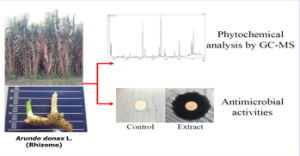Phytochemical Compounds in Arundo donax L. Rhizome and Antimicrobial Activities
Highlight:

- Arundo donax rhizome extracts reveal a diverse array of compounds including sterols, lipids, fatty acids, phenolics, terpenoids, xanthones, and xanthene.
- the significant antimicrobial activity of the rhizome extracts against Gram-positive bacteria.
- Hierarchical clustering analysis reveals specific compounds, such as hexadecanoic acid and xanthone, which correlate with the inhibition of bacterial growth, offering insights into the potential mechanisms underlying the observed antimicrobial effects
Researcher Name: Dr. Netiya Karaket collaborated with Dr. Kanokip Pansuksan
Years of execution: 2018-2019
Funder Name: Thammasat University under the TU New Research Scholar, Contract No. 21/2559
Objectives: to characterize the phytochemical composition of Arundo donax L. rhizome extracts and evaluate their antimicrobial activity
Abstract:
The aerial part of Arundo donax L., giant reed, is a well-known fuel source used in many countries. Phytochemical compounds in A. donax L. rhizome, sequentially extracted with hexane (HEX), dichloromethane (DCM), ethyl acetate (EA), and methanol (MeOH), were identified using gas chromatography-mass spectrometry. Antimicrobial activities of the rhizome extracts were evaluated using disc diffusion assay against yeast (Candida albicans), and bacteria Gram-positive (Staphylococcus aureus ATCC 25923, Bacillus cereus ATCC11778, and Bacillus subtilis ATCC6633) and Gram-negative (Escherichia coli ATCC25922). The detected phytochemicals were screened against WILEY07 library; 84 compounds matched with a similarity ≥ 90%. All the characterized compounds were grouped based on their functional group. The major phytochemicals in the HEX, DCM, and EA extracts belonged to sterol groups, while lipids, fatty acids, and related conjugates were the main components of the methanolic extract. The other characterized compounds were hydrocarbons, phenolics, terpenoids, xanthones, and xanthene. Growth of B. subtilis was inhibited by the HEX, DCM, EA, and MeOH extracts, whereas B. cereus growth was inhibited only by the DCM and EA extracts. However, the growth of E. coli and C. albicans could not be inhibited by A. donax L. rhizome extracts. Analysis of the compounds and their antibacterial activities via hierarchical clustering showed that hexadecanoic acid is the major compound influencing B. subtilis growth, while B. cereus growth was affected by xanthone. Conclusions: Rhizomes of A. donax L. is one potential source of antimicrobial agents and further applied in medicinal uses.
Reference:
Pansuksan K, Sukprasert S, Karaket N. Phytochemical Compounds in Arundo donax L. Rhizome and Antimicrobial Activities. Pharmacog J. 2020;12(2):287-92. http://dx.doi.org/10.5530/pj.2020.12.45
